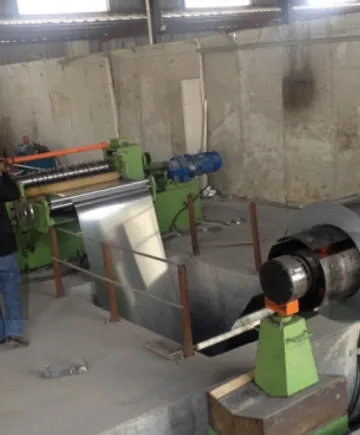
For manufacturers battling tight deadlines and material waste, metal slitting revolutionizes production efficiency. This precision process transforms wide metal coil slitter machine outputs into narrow strips, accelerating downstream operations. By integrating advanced metal slitting inneal technology, factories slash processing time by up to 70% while reducing scrap by 30%. The ripple effect? Faster order fulfillment, leaner inventories, and higher profit margins.

Metal slitting is a high-speed, rotary-knife cutting process that converts master coils into precise widths for stamping, roll forming, or fabrication. Unlike shearing, it maintains material integrity at production speeds exceeding 1,000 feet/minute. Industries from automotive to aerospace leverage slitting to eliminate secondary cutting: A single metal coil slitter machine can process 50,000 tons annually, replacing 3-5 traditional workflows. The secret lies in its synchronized components—uncoilers, tensioners, and servo-driven knives—which adapt to materials like stainless steel, aluminum, or copper with micron-level accuracy.
A modern metal coil slitter machine combines robust mechanics with digital intelligence. Key features include:
Operators achieve 98% material utilization via programmable width adjustments, allowing instant shifts between jobs. For example, processing 0.2mm-thin electronics brass requires feather-touch tensioning, while 6mm structural steel demands 20-ton clamping force—all managed through one HMI interface.
Deploying a metal slitting inneal triggers measurable productivity leaps:
Data from automotive suppliers shows slitting lines finishing 8-hour jobs in 90 minutes. One HVAC manufacturer cut energy costs by 18% after retiring hydraulic shears in favor of electric metal slitting machines.
Modern metal slitting leverages cutting-edge engineering to achieve unprecedented accuracy and efficiency. At its core, precision starts with ultra-hardened tungsten carbide or ceramic rotary knives, mounted on dynamically balanced arbors that eliminate vibration at speeds exceeding 2,000 FPM. These components integrate with AI-driven laser micrometers that scan material 1,000 times per second, auto-adjusting knife gaps to maintain ±0.0005-inch tolerances across stainless steel, copper, or aerospace-grade aluminum. Crucially, rigid split-shaft designs in metal coil slitter machines prevent deflection during high-tension cuts, ensuring consistent strip widths even at 0.05mm thicknesses.
Thermal stability systems counteract blade expansion using liquid-cooled spindles, while IoT-enabled load sensors monitor real-time knife wear. This engineering synergy allows a single metal slitting inneal to switch between 30+ material grades in minutes via digital presets. For example, slitting transformer steel demands near-zero burrs (<0.1mm), achieved through nano-coated blades and micro-tension control. The result? Near-zero scrap rates (99.8% yield) and 24/7 operational reliability. By merging mechanical robustness with predictive algorithms, modern slitters transform raw coils into dimensionally perfect strips – turning precision into profit.
Advanced models maintain ±0.001-inch width consistency and burr-free edges, even at speeds over 1,500 FPM. Precision is ensured via laser micrometers and closed-loop tension control.
Rotary knives create narrower kerf (0.1mm vs. 1mm for saws), preserving valuable material. Edge-trim optimization algorithms further minimize scrap, achieving 98%+ yield rates.
Yes. Quick-change tooling adapts knives for steel, aluminum, copper, or exotic alloys. Tension presets auto-adjust for material hardness and thickness (0.1–6mm).
Light curtains, emergency brakes, and AI vision detect operator proximity or coil defects, triggering instant stops. Fully enclosed cutting zones prevent debris exposure.
Digital models with memory presets change widths in under 3 minutes. Manual systems require 15–20 minutes per adjustment.
Stop letting inefficient cutting strangle your throughput. The latest metal slitting machines are force multipliers—transforming labor-intensive chaos into streamlined, automated precision. Imagine slashing material costs by 30%, doubling shift output, and quoting tighter tolerances that competitors can’t match. Industry leaders aren’t waiting; they’re upgrading to AI-enhanced slitters that self-optimize blade angles and feed speeds.
Act Today:
Procrastination costs more than machinery. While you hesitate, rivals are capturing market share with faster deliveries and leaner pricing made possible by metal slitting. Seize your competitive edge—explore cutting-edge solutions today.